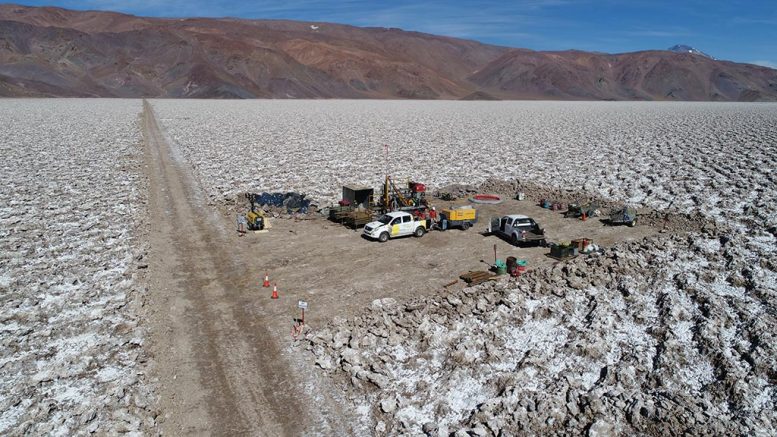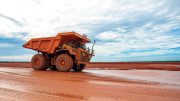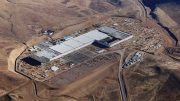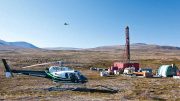AVALON ADVANCED MINERALS

Senior geologist Chris Pedersen in a core shack at Avalon Advanced Materials’ Separation Rapids lithium project near Kenora, Ontario. Credit: Avalon Advanced Materials.
Avalon Advanced Minerals (TSX: AVL; US-OTC: AVLNF) is a Canadian mineral development company specializing in sustainably-produced materials for clean technology.
The company has three advanced-stage projects with exposure to lithium, tin and indium, as well as rare earth elements tantalum, niobium and zirconium. It is advancing its Separation Rapids lithium project near Kenora, Ontario; its East Kemptville tin-indium project in Yarmouth, Nova Scotia; and the Nechalacho rare earth elements property near Yellowknife at Thor Lake in the Northwest Territories.
The Nechalacho rare earth elements project shows potential for the economic recovery of zirconium, beryllium, niobium, and tantalum as well as lithium. The presence of high grade, near-surface light rare earth element resources enriched in neodymium-praseodymium (Nd-Pr) in the T-Zone and Tardiff Zones of the property also hold promise for near-term, small-scale development to produce Nd-Pr-rich concentrates for export.
In June 2019, Avalon and Cheetah Resources signed a purchase and sale agreement, with Cheetah acquiring ownership of the near-surface T-Zone and Tardiff Zone resources for $5 million.
In January, the company awarded a contract for mining the T-Zone rare earth element resources to Det’on Cho Nahanni Construction Corp., the economic development corporation of the Yellowknives Dene First Nation.
In October, Avalon signed a binding letter of intent with Coal Strategy Advisors, a private U.S. company, to earn up to a 50% interest in Will Scarlett, a closed coal mine site where previous geochemical sampling found elevated levels of rare earths and other elements such as cobalt, nickel, lithium, manganese and zinc in mine waste.
Since the signing, Avalon has been working on plans to extract mixed rare earth oxide products from the mine. The company is evaluating a low-cost earth recovery process and has plans to run a small-scale pilot facility to confirm recoveries and the scalability of the process.
Avalon Advanced Minerals has a $9.6-million market cap.
E3 METALS
E3 Metals (TSXV: ETMC; US-OTC: EEMMF) is a lithium exploration company headquartered in Calgary, Alberta. The company is developing a new source of lithium from reservoirs in the province, which overlie the Leduc Reef, and contain oil and gas reserves and lithium brines.
Total inferred resources for the Leduc Reef total 6.7 million tonnes of lithium carbonate equivalent (LCE), which includes 1.9 million tonnes LCE for their Central Clearwater Resource Area, 0.93 million tonnes LCE for the North Rocky Resources Area and 3.9 million tonnes of LCE for the Exshaw West Resource Area.
In May, the company successfully produced lithium hydroxide concentrate from brine collected from the Alberta lithium project using the company’s propriety direct lithium extraction ion exchange technology, and which demonstrated the validity of the company’s process flowsheet.
In July, the company, in collaboration with GreenCentre Canada and Kingston Process Metallurgy and with support from Alberta Innovates, commissioned a lab-scale lithium extraction flow system, which will be used to test and improve the performance of their extraction technology as the first step towards a pilot-scale system.
In September, the company announced a joint development agreement with Livent (NYSE: LTHM). Their combined technical team is now assessing the commercial readiness of E3 Metals’ proprietary technology for separating high purity lithium concentrate from the brine contained at the company’s properties.
This year the company plans to conduct well testing, including brine pressure testing, improve its reservoir model, collect data on lithium concentrations outside the oil and gas accumulations, and update delivery plans for brine resources located on the property.
E3 Metals has a $9.62-million market cap.
FIRST COBALT

First Cobalt’s cobalt refinery in northern Ontario. Credit: First Cobalt.
First Cobalt’s (TSXV: FCC; US-OTC: FTSSF) flagship asset is the First Cobalt refinery in Ontario, about 600 km from Canada’s border with the U.S. It is the only fully permitted primary cobalt refinery in North America, the company says. When operational, the refinery could supply cobalt sulphate for lithium-ion batteries for the North American electric car market, the aerospace industry, and other industries.
In August, the company entered into a US$5 million loan facility with Glencore (LSE: GLEN) to complete engineering work, metallurgical testing, fieldwork, and permitting for the recommissioning and expansion of the refinery.
On completion of a positive feasibility study, Glencore is prepared to make a further US$40 million available for a 55-tonne-per-day expansion of the refinery. In December, the company announced its intention to recommission and expand the refinery in partnership with Glencore.
The company is completing a pre-feasibility study for a 12-tonne-per-day restart of the refinery and a definitive feasibility study for a 55-tonne-per-day production scenario. It is also working with Story Environmental to ensure that existing permits comply with a 12-tonne-per-day restart and developing new baseline studies ahead of amending any existing permits for the proposed 55-tonne-per-day expansion.
An assessment by Ausenco Engineering Canada confirmed the serviceability of on-site equipment for both a 12-tonne- per-day and 55-tonne-per-day processing scenario. Geotechnical drilling on a new tailings area by Knight Piésold has been completed and will support design work for a 55-tonne-per-day dry-stacked tailings management facility.
In January, the company announced an updated resource estimate for its Iron Creek cobalt project in Lemhi County, Idaho. The project now contains an indicated resource of 2.15 million tonnes of cobalt grading 0.32% cobalt equivalent (0.26% cobalt and 0.61% copper) for 12.25 million lb. cobalt and 29 million lb. copper. Inferred resources add 2.68 million tonnes grading 0.28% cobalt equivalent (0.22% cobalt and 0.68% copper) for an additional 12.69 million lb. cobalt and 39.94 million lb. copper.
The company’s third project is a significant land package in the Canadian cobalt camp near Cobalt, Ontario. The property spans more than 100 sq. km. and contains more than 50 past-producing cobalt-silver mines. First Cobalt is re-evaluating historical cobalt-silver mineralized systems on the property.
First Cobalt recently closed a private placement raising $2.1 million and has a $52.29-million market cap.
NEO LITHIUM

Neo Lithium’s Tres Quebradas lithium project in Argentina’s Catamarca province. Credit: Neo Lithium.
Neo Lithium (TSXV: NLC; US-OTC: NTTHF) is advancing its Tres Quebradas (3Q) lithium project in Argentina’s Catamarca province.
Discovered in 2015, the 3Q project is a high-grade lithium brine lake covering about 35,000 hectares, located in the “Lithium Triangle” and the largest lithium-producing area in the country. The 16,000-hectare salar complex is supplied by hot springs with elevated lithium levels.
In May 2019, an updated prefeasibility study demonstrated that the project could produce an average of 20,000 tonnes a year of lithium carbonate equivalent (battery grade) over a 35-year mine life.
In October, the company announced that 610 hectares of land had been allocated by the municipality of Fiambala for the development of the Fiambala industrial park. The grant includes a 349-hectare parcel of land that will be given to Neo Lithium, for the future construction of the company’s full-scale lithium carbonate plant.
The industrial park will be powered by electricity from the recently built 11-megawatt solar plant in Fiambalá and will also be connected to a new 22-megawatt solar energy plant in the nearby city of Tinogasta. It will use water supplied at a recently drilled well, able to provide water at 200 cubic metres per hour.
Neo Lithium has a $76.4-million market cap.
NOUVEAU MONDE GRAPHITE

Core racks at Nouveau Monde Graphite’s Matawinie project in Quebec. Credit: Nouveau Monde Graphite.
Nouveau Monde Graphite (TSXV: NOU; US-OTC: NMGRF) is developing the Matawinie graphite mining project in Saint-Michel-des-Saints, 150 km north of Montreal, Quebec.
In October 2018, the company published a feasibility study on the West Zone deposit of the Matawinie project’s Tony claim block. The study projected graphite concentrate production of 100,000 tonnes a year over a mine life of 25.5 years producing an average concentrate purity greater than 97%.
The pit-constrained indicated resource in the West Zone stands at 95.8 million tonnes grading 4.28% Cg for 4.1 million tonnes of graphite and 14 million inferred tonnes grading 4.19% Cg at a cut-off grade of 1.78% Cg.
The company has started producing graphite at its 3.5 tonne-per-hour demonstration plant, also located in Saint-Michel-des-Saints, where it produces concentrated flake graphite. The graphite is being sent to potential clients in North America and overseas.
The company is planning a large-scale secondary graphite transformation facility, catering to the lithium-ion battery industry.
Nouveau Monde says the Matawinie graphite project will be the first of its kind to operate as an all-electric, low-carbon mine.
A major drilling program carried out in 2019 at Matawinie’s West Zone of the Tony Block generated 3,928 samples from 77 holes over 13,250 metres. The results of the drilling will be released before the end of the first quarter of this year.
Nouveau Monde Graphite has a $64.14-million market cap.
NRG METALS
NRG Metals (TSXV: NGZ; US-OTC: NRGMF) is developing the Hombre Muerto Norte (HMN) lithium project, the company’s flagship lithium brine property in northwestern Argentina’s Salta and Catamarca provinces.
The project is surrounded by ground now owned by POSCO, a Korean lithium producer, and is about 12 km from FMC’s (NYSE: FMC) Fenix lithium mine.
HMN has 509,000 tonnes of lithium carbonate equivalent (LCE) and 1.6 million tonnes of potash (KCl) equivalent in the measured resource category, with another 62,000 tonnes of LCE and 231,000 tonnes KCl in the indicated category. The average grade of lithium for the 571,000-tonne combined measured and indicated resource is 756 milligrams lithium per litre, with a low lithium to magnesium ratio of 2.6 to 1.
The company completed a preliminary economic assessment on the project in August 2019, outlining a 30-year mine life and annual average production of 5,000 tonnes of lithium carbonate. Initial capex was estimated at US$93.4 million and the study forecast an after-tax net present value at an 8% discount rate of US$217 million and an after-tax internal rate of return of 28%.
In December 2019, shareholders approved the sale of the HMN project to Alberdi Energy for US$18 million, but also approved a provision for a board review and acceptance of superior offers to Alberdi Energy’s proposal. Alberdi Energy is part of the Alberdi Group, an international Argentina-based company with a 112-year history and interests in ceramic manufacturing, industrial park construction, mining, and more recently, renewable energy.
NRG Metals has a $2.71 million market cap.
OSISKO METALS

A drill rig at Osisko Metals’ historic Pine Point lead-zinc project in the Northwest Territories. Credit: Osisko Metals.
Osisko Metals (TSXV: OM; US-OTC: OMZNF) is a base metals exploration company with a primary focus on zinc.
The company controls two of Canada’s premier zinc mining camps: Pine Point, located on the south shore of Great Slave Lake in the Northwest Territories, and the Bathurst mining camp, south of Bathurst in New Brunswick.
In November, Osisko completed a resource estimate for Pine Point. Resources stand at 52.4 million inferred tonnes grading 4.64% zinc and 1.83% lead (6.47% zinc equivalent) for 5.3 billion lb zinc and 2.1 billion lb lead. Underground mineral resources totalled 4.5 million tonnes grading 5.76% zinc and 2.43% lead (8.19% zinc equivalent), with the pit-constrained resource of 47.9 million tonnes grading 4.54% zinc and 1.78% lead (6.31% zinc equivalent).
The company plans to update the resource estimate for Pine Point to accompany an upcoming preliminary economic assessment slated for the second quarter of this year.
In the eastern portion of the Bathurst mining camp, Osisko completed a resource estimate in February 2019 at two properties, Key Anacon and Gilmour South.
Indicated resources stand at 1.96 million tonnes grading 5.77% zinc, 2.38% lead, 0.22% copper, and 68.9 grams silver per tonne (9% zinc equivalent) for 249.1 million lb. zinc, 102.6 million lb. lead, 9.3 million lb. copper, and 4.3 million oz. silver. Inferred resources add 3.85 million tonnes grading 5.34% zinc, 1.49% lead, 0.32% copper, and 47.7 grams silver per tonne (7.96% zinc-equivalent) for 453 million lb. zinc, 126.4 million lb. lead, 27 million lb. copper, and 5.9 million oz. silver.
In late January, the company appointed Robert Wares as CEO and Jeff Hussey as chief operating officer. Wares retains his role as executive chairman, and Hussey will continue to serve as president.
Osisko Metals has a $74.40-million market cap.
POWERORE
PowerOre (TSXV: PORE) is exploring for copper and gold in the Opemiska copper complex in the Chibougamau region near the town of Chapais, Quebec.
Between 1953 and 1991, Falconbridge mined a total of 23 million tonnes of ore grading 2.4% copper and 0.3-gram gold per tonne from the site’s Springer and Perry underground mines.
PowerOre was spun out in 2018 as an energy metals junior by Stephen Stewart’s Orefinders Resources (TSXV: ORX) and bought a full interest in Opemiska from privately held Explorateurs-Innovators de Quebec.
In the spring of 2019, PowerOre drilled 23 holes in a 3,364-metre program to test for surface mineralization. The drill program also assisted the company validate historical drill data.
Highlights included 4.65% copper equivalent over 7.9 metres from 81.1 metres in hole 19-19; 4.15% copper-equivalent over 25 metres from 38 metres in hole 19-18; and 3.07% copper equivalent over 43 metres from 38 metres in hole 19-14. The drill program also returned twelve mineralized intercepts of over 100 metres long.
Opemiska falls within the boundary of Plan Nord.
PowerOre also owns the Mann silver-cobalt mine property in Milner township, west of Cobalt, Ontario, within the renowned Temiskaming silver area. The 867-hectare property contains the historic Mann mine, which produced 330,000 oz. silver prior to 1987. The Mann property contains nine historic shafts and a ramp driven to the 210-foot area. Results from historic drilling by previous owners included 1.4 metres of 1.12% cobalt; 29.3 metres of 131 grams silver per tonne; and 28.7 metres of 181 grams silver per tonne.
On Feb. 25, the company announced that it has entered into an agreement to sell the mine to Rider Investment Capital Corp. (TSXV: RDRP) at an implied U$1.25 million valuation.
The company also owns the early stage MacMurchy nickel property, 25 km west of the Mann property in the southwestern corner of MacMurchy Township.
PowerOre has a $3.48-million market cap.





The battery metals are very interesting and as a former analyst covering inco 20 years ago, they have been a long time coming! Often overlooked is silicon, which Canada has an abundance of but it needs processing into silicon metal and nano powders. There is only one serious silicon metal company, HPQ Silicon. HPQ with technical partners Pyrogenesis and Apollon is close to finalizing its pilot plant to produce high purity silicon metal, and is developing a process for silicon nano podwers and wires. With the loss of a major energy project, with Teck concluding it cannot proceed with its oil sands project, Canadians at all levels must embrace the future by investing in these new age companies. Silico is essential for solar panels and has great pitential for Li iin battery anodes. Time to understand what made this country great: Innovative uses of our resources. After all, look around, if it can’t be grown, it has to be mined.